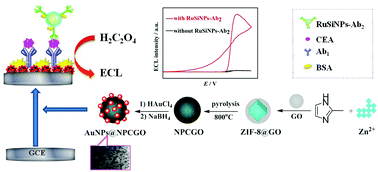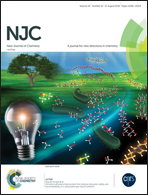A metal–organic framework nanomaterial as an ideal loading platform for ultrasensitive electrochemiluminescence immunoassays
Abstract
An ultrasensitive sandwich-type electrochemiluminescent (ECL) immunosensor suitable for identifying carcinoembryonic antigens (CEAs) was developed, using a metal–organic framework nanomaterial (AuNP@NPCGO) as an ideal loading platform and Ru(phen)32+-doped silica nanoparticles (RuSiNPs) as ECL signaling units. The AuNP@NPCGO nanocomposites were synthesized via in situ deposition of AuNPs on NPCGO as this configuration exhibits high conductivity, strong fixed ability, and excellent stability. The use of RuSiNPs as signaling units provided numerous luminophores that enhanced the ECL signals. Besides the aminated RuSiNPs, which had a large specific surface area and good biocompatibility, functioned as a superior matrix for immobilizing numerous secondary antibodies (Ab2). The proposed ECL immunosensor demonstrated excellent performance for CEA detection at concentrations of 0.01 ng mL−1 to 80 ng mL−1 with a detection limit of 0.003 ng mL−1 at a signal-to-noise ratio of three.



 Please wait while we load your content...
Please wait while we load your content...